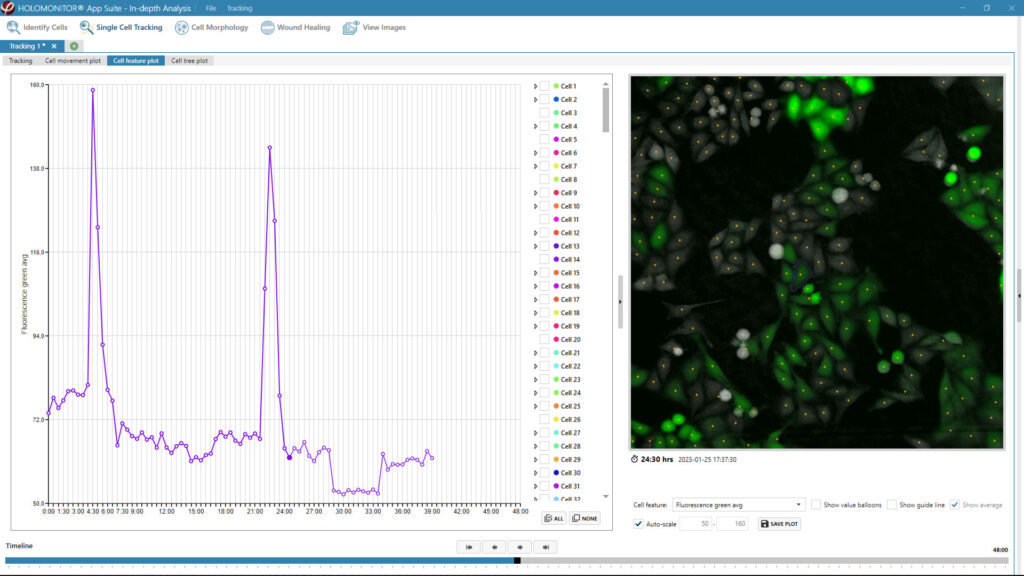When Holography meets Fluorescence
- Combining holography and fluorescence data in one experiment
- Minimal light exposure to reduce photocytotoxicity
- Small footprint so it fits inside your incubator
- Long-term, single-cell and cell population data
- Intuitive and guided workflow from setup to analysis
Unlock the Power of Fluorescence
HoloMonitor M4 + Fluorescence = HoloMonitor M4FL
The fluorescence add-on is compatible with the HoloMonitor M4 system. This way, you can tailor the HoloMonitor Live Cell Assays to your needs and add fluorescence to your HoloMonitor system to best fit your research application.
- Single Cell Tracking Assay
The HoloMonitor® Single Cell Tracking Assay enables automatic adherent cell tracking for detailed label-free studies of single-cell behavior with optional fluorescence.
- Kinetic Dose Response Assay
The label-free HoloMonitor® Kinetic Dose-Response Assay is designed for automated and detailed analysis of drug dose responses in adherent cells
- Kinetic Cell Motility Assay
The HoloMonitor® Kinetic Cell Motility Assay is ideal for studies investigating how different drug treatments influence cell population movement over time.
The HoloMonitor® Cell Morphology Assay enables high-content, non-invasive and kinetic analysis of a wide range of morphological properties with optional fluorescence.
The HoloMonitor® Wound Healing Assay enables automatic, non-invasive cell migration analysis giving you accurate, kinetic gap closure data in real-time.
- Cell Quality Control Assay
The HoloMonitor® cell culture quality control (Cell QC) assay ensures your cells’ quality, avoids contaminated cells, and detects undesired cell changes.
The HoloMonitor® Cell Counter is designed for automated cell counting of suspension cells with high-precision results within one minute.
- Kinetic Cell Proliferation Assay
HoloMonitor® Kinetic Cell Proliferation Assay is designed for automated and detailed proliferation analysis of adherent cells.
App Suite 4.0 software for fluorescence
The HoloMonitor® App Suite cell imaging software facilitates kinetic live-cell tracking and analysis of your cells right from your incubator. In addition to detailed single-cell and cell population data, App Suite provides you with visual data in the form of high-quality images and time-lapse videos of your in vitro cell cultures. Moreover, you can easily re-analyze the imaging results of previous experiments. With the HoloMonitor live cell assays, you can extract multiple results anytime from your samples. And, of course, this cell imaging software allows for convenient data analysis from outside the lab.
Featured Applications
Illuminate, Analyze and Discover
- Cell Death
- Reporter Gene Expression
- Co-Culture
- Transfection Efficiency
- Uptake Assay
- Live Cell Staining
Assay Output
In addition to all the label-free holography cell features to study your cells’ behavior, you can analyze your cells’ fluorescence signal in HoloMonitor’s Single Cell Tracking and Cell Morphology Assay.
Single Cell Tracking Assay
The HoloMonitor® Single Cell Tracking assay offers user-friendly software for continuous, label-free imaging and tracking of adherent cells, enabling in-depth characterization of heterogeneous cell behavior at the single-cell level. With the add-on fluorescence unit, you can add a green fluorescence dimension to the holography data, providing enhanced insights into your cell cultures.

Cell Morphology Assay
The label-free HoloMonitor® Cell Morphology Assay enables non-invasive live cell imaging and kinetic analysis of a wide range of morphological properties, including individual cell volume, area, and thickness. With the add-on fluorescence unit, you can add a green fluorescence dimension to the holography data, providing enhanced insights into your cell cultures.

HoloMonitor M4FL User Reviews
HoloMonitor M4FL is on the trusted Select Science review website. You can explore experiences from other scientists about our live cell analysis tools, their various applications in cell research, and our services.
Read more reviews HERE.

 SingaporeSG
SingaporeSG ChinaCN
ChinaCN MalaysiaMY
MalaysiaMY IndonesiaID
IndonesiaID MyanmarMM
MyanmarMM




